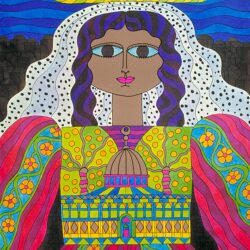MoMu Pattern-A-Thon shares fashion heritage with the world

The first Pattern-A-Thon took place in MoMu Library on November 27. This project, which forms part of the activities of the Dries Van Noten Study Center, is intended to find new ways of sharing heritage more widely and promoting the active involvement of citizens.
MoMu and the European Fashion Heritage Association (EFHA) - organised the Pattern-A-Thon in collaboration with KU Leuven, the University of Antwerp, and Erasmus University Rotterdam, within the framework of the CitizenHeritage-project, that leverages citizen science practices in the Cultural Heritage sector. During the event, participants recreated patterns from pieces in the study collection and subsequently posted them on Wikimedia Commons where they can be viewed and used by everyone.

Dieter Suls (MoMu): “Museum collections these days are ever better and more professionally managed but have become less accessible as a result. This is why MoMu, separate from the collection that is meticulously preserved in our external depot, has built an easily accessible study collection. It comprises objects that are no longer top items, for example, items that have been damaged to such an extent that they are no longer suitable for exhibitions, or of which we own multiple specimens. Their purpose is to allow people to learn about their construction or discover how they feel to the touch. This direct contact is very important. They form a unique source of research and inspiration."
“The Pattern-A-Thon is a novel way of making the study collection work for all. It fits with the idea of cocreation and user engagement: people use the collection to create a pattern that can then be reused by other people. There are many books on patterns, or communities around them. Now we, as a museum, want to make our own contribution by making our collection available. This is a first experiment within the wider story of citizen heritage. We are considering whether we can set up this format elsewhere as well, and how we can share the output in a similar manner. As such, a larger community is created in which the collections of the world are crowdsourced and share

The participants form a mix of students and other interested persons who may or may not be professionally involved in fashion. Natalie Ortega (University of Antwerp) is their coach: “It is important that many people should copy the patterns because this way the museum wants to unlock a database which is accessible to everyone. It can serve as a source of inspiration for designers, TV and theatre producers or people looking to create something for themselves. Patterns are also important in conservation and restoration. When you want to exhibit an object, you have to know its construction in order to use the right mannequin. When a particular object is in a very poor condition, it is important to know and be able to cut the missing pattern piece that is to be inserted as a substitute. Due to the need for a more ecological lifestyle, a growing number of people are interested in making things themselves. Patterns form part of this trend. I also hope that more and more we will come to realise that clothing is something quite valuable that you cannot buy for ten euros. It involves a whole production process."

Frederik Truyen (KU Leuven) emphasises the importance of digitisation to make possible the creative reuse of this type of heritage: “Citizens must have a say in the determination of what is heritage, in what is being selected, how it is being preserved. The past decade has seen much crowdsourcing, people have been more and more encouraged to make their own contribution to the heritage. It's only thanks to digital tools that we can now share this knowledge with many people. The best protection of heritage is when new generations reuse it to create new heritage and thus breathe new life into it. In addition, this way of digitisation is also of importance to TV and theatrical producers who want to re-enact the past as realistically as possible. Fashion is an integral part thereof."

Marco Rendina (EFHA): “The digitisation of heritage enables cultural institutions to better exploit it. Not so much economically, but rather on a social, creative, and innovative level. With events like the Pattern-A-Thon we are trying to attract a non-specialised public. We encourage museums to make their collections accessible on Wikimedia so that everybody can engage with them on many different levels. Knowledge produced by citizens is not necessarily without merit, it can make a real contribution to research and knowledge. A study collection such as MoMu's is still quite unusual, but very important. It allows us to actively reflect on heritage, and turn it into knowledge, thus unlocking free-to-use output on Wikimedia. In organising events like these, we hope to encourage other institutions to establish similar collections that people can study and touch. Unlocking collections and allowing people to incorporate them into new creative endeavours mainly involves sharing images, for instance, to print them on a T-shirt. With this initiative we want to boost creativity and reinvigorate heritage by understanding it, reproducing it and finally wearing it. Not just the public, but also the very collection can draw strength from such events."
We are still evaluating the process and output of the event. But you can already discover the tentative results of the workshop on Wikimedia.


